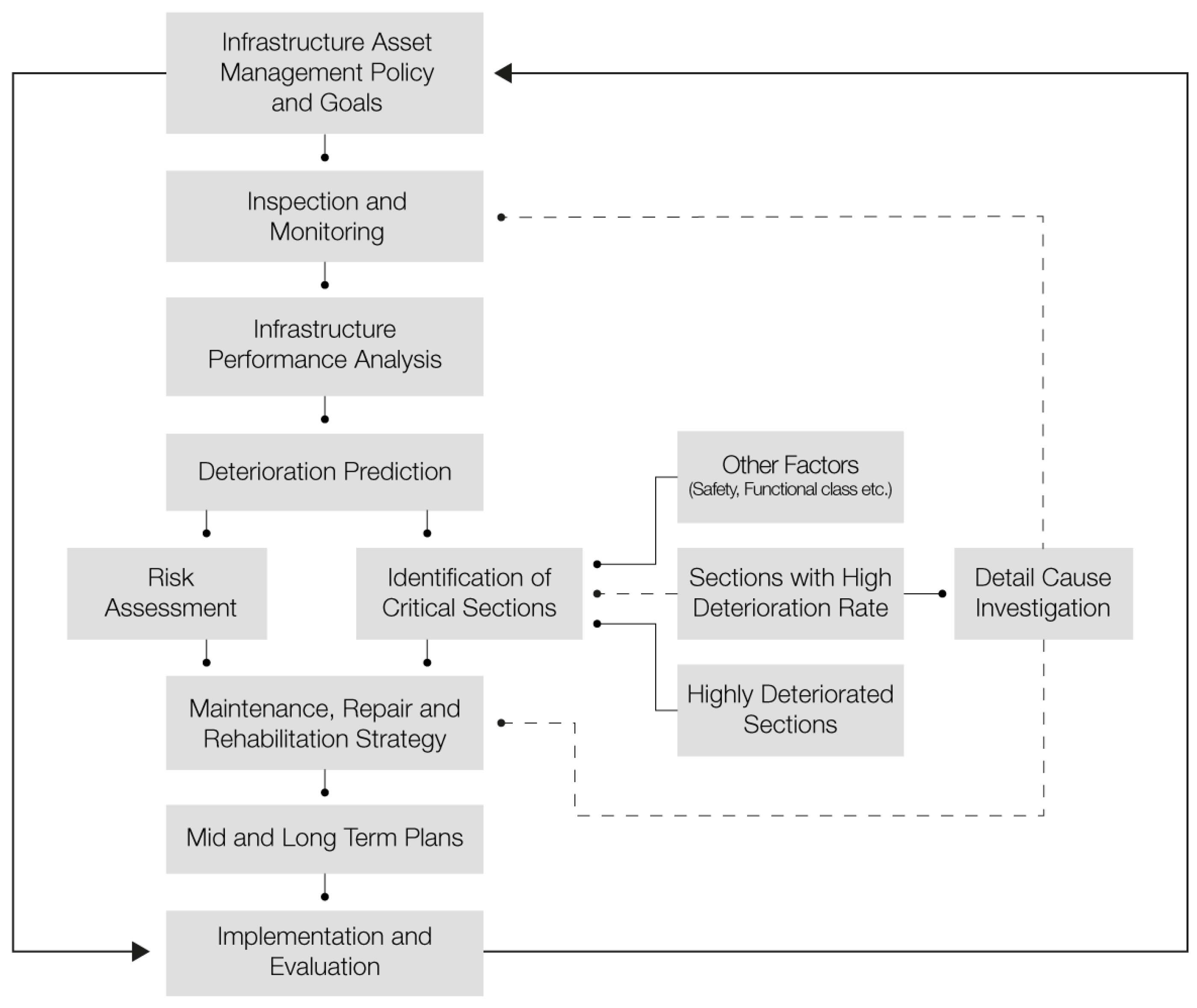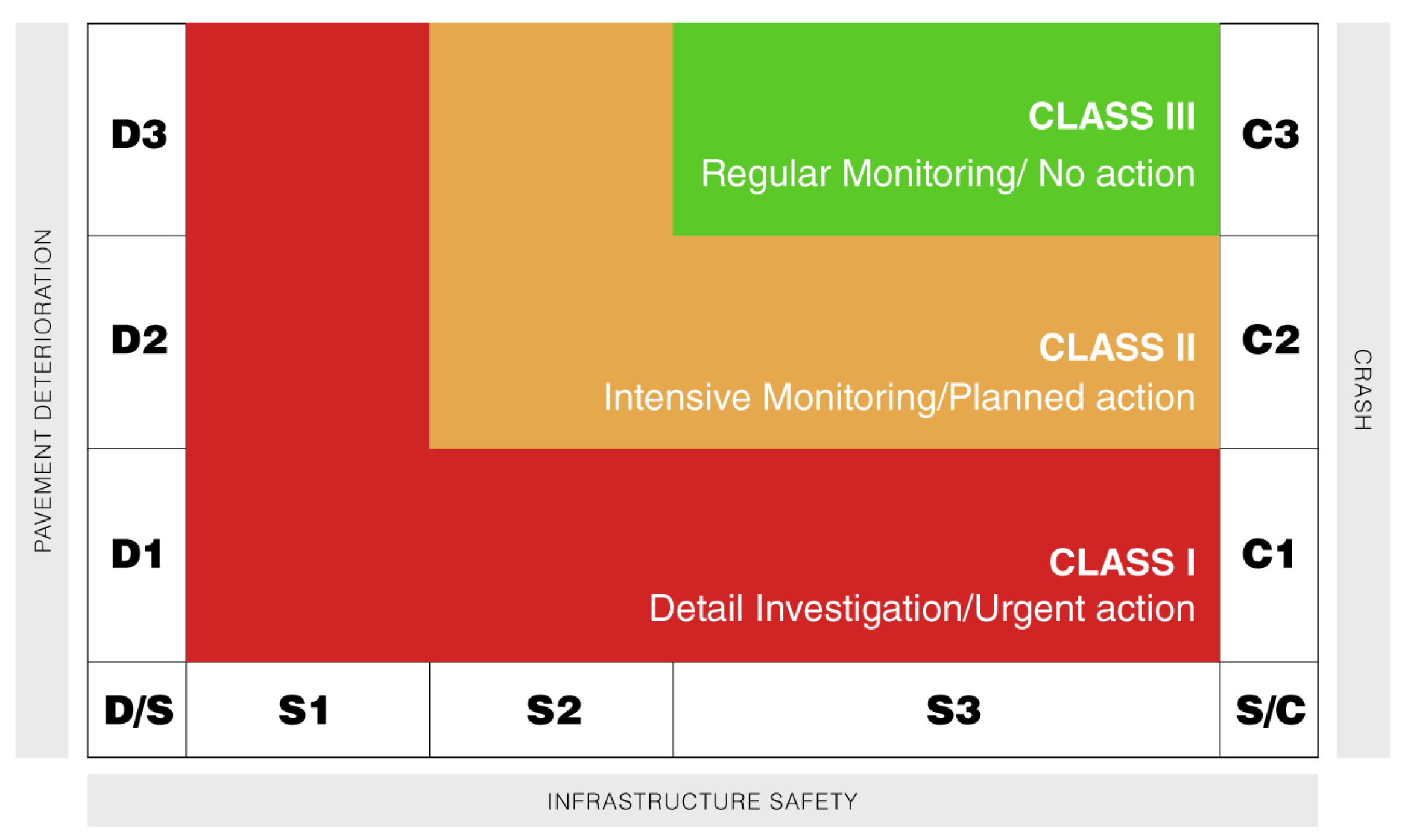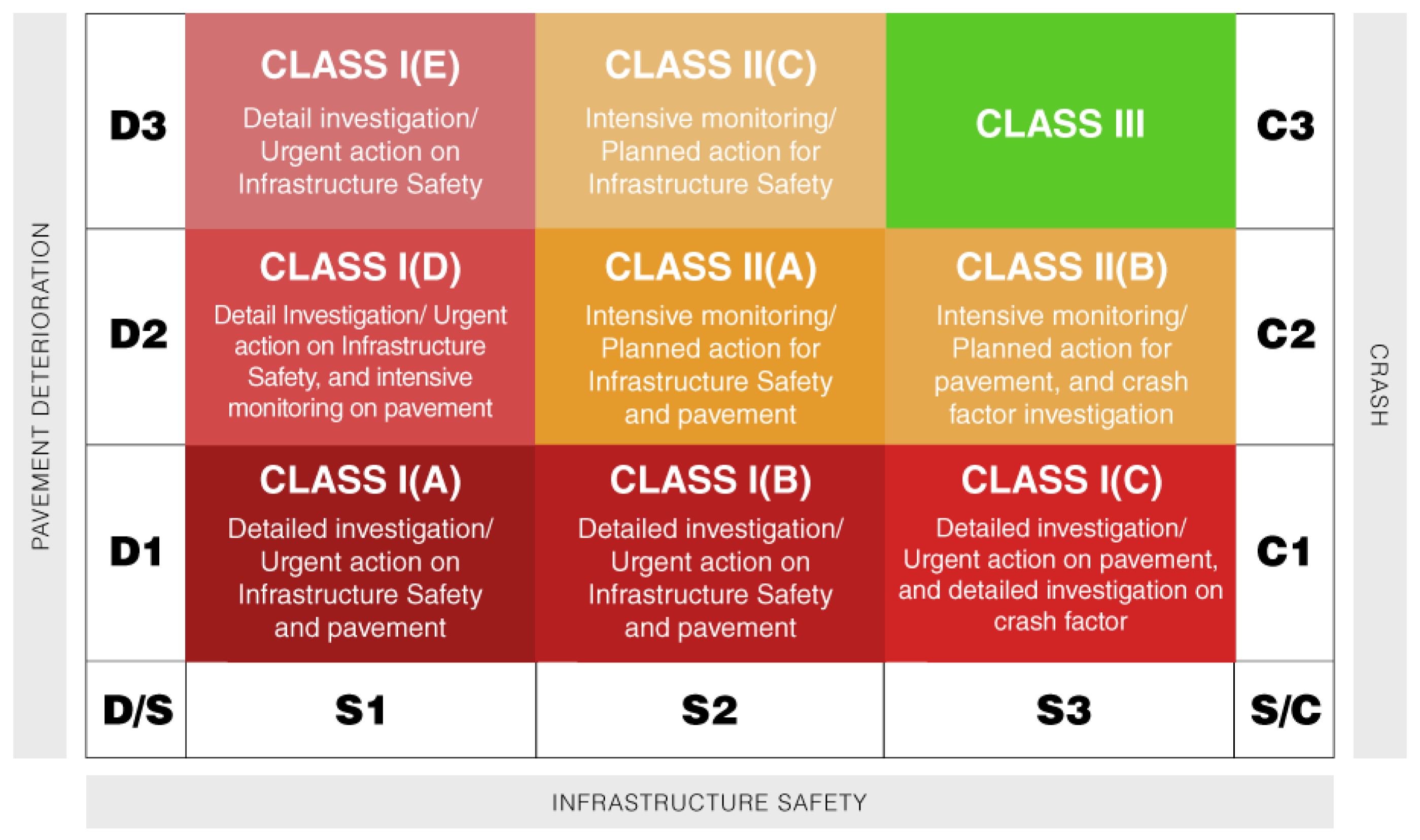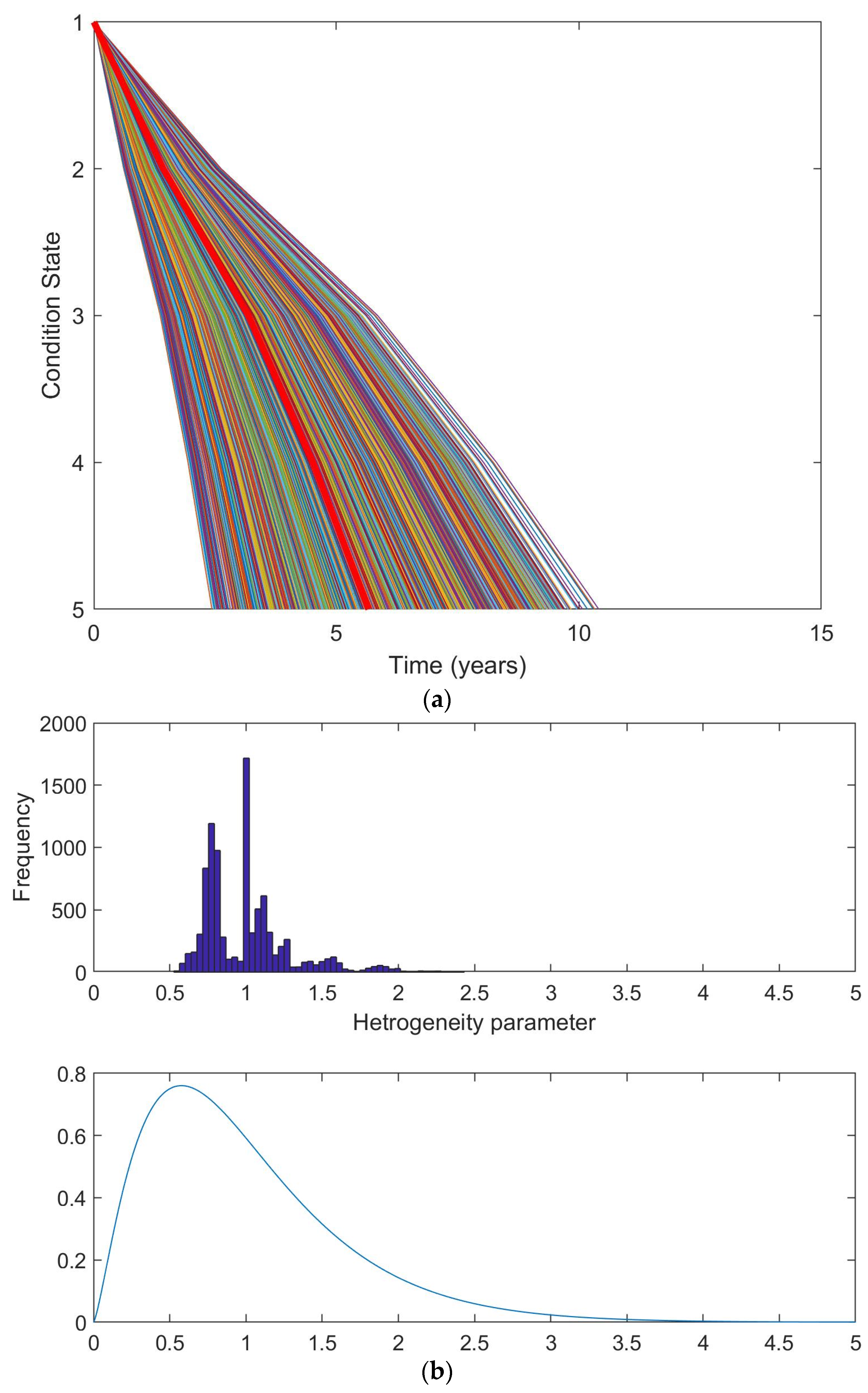Assessing Critical Road Sections: A Decision Matrix Approach Considering Safety and Pavement Condition
Abstract
1. Introduction
2. Literature Review
- It uses a proactive approach to evaluate pavement performance.
- It considers a comprehensive set of factors to evaluate the safety of infrastructure for each group of road users separately.
- It uses crash history data to assess the underlying causes of accidents, in addition to the proactive safety assessment of infrastructure.
- It introduces a new decision-making matrix that combines the above three factors and applies the proposed matrix to prioritize road maintenance in a real case study in Addis Ababa, Ethiopia.
3. Methodology
3.1. Markov Mixed Hazard (MMH) Model
3.2. International Road Assessment Program (iRAP) Star Rating
3.3. Decision Matrix Formulation
3.4. Empirical Setting: Case Study
4. Results
5. Discussion
6. Conclusions
Author Contributions
Funding
Data Availability Statement
Acknowledgments
Conflicts of Interest
References
- Canning, D.; Bennathan, E. The Social Rate of Return on Infrastructure Investments; The World Bank: Washington, DC, USA, 2000. [Google Scholar]
- Gunasekera, K.; Anderson, W.; Lakshmanan, T.R. Highway-induced Development: Evidence from Sri Lanka. World Dev. 2008, 36, 2371–2389. [Google Scholar] [CrossRef]
- Ng, C.P.; Law, T.H.; Jakarni, F.M.; Kulanthayan, S. Road Infrastructure development and Economic Growth. In Proceedings of the 10th Malaysian Road Conference & Exhibition, Selangor, Malaysia, 29–31 October 2018. [Google Scholar] [CrossRef]
- Burningham, S.; Stankevich, N. Why Road Maintenance Is Important and How to Get It Done; The World Bank: Washington, DC, USA, 2005. [Google Scholar]
- Okte, E.; Al-Qadi, I.L.; Ozer, H. Effects of Pavement Condition on LCCA User Costs. TRR 2019, 2673, 339–350. [Google Scholar] [CrossRef]
- Hammarstrom, U.; Erikson, J.; Karlson, R.; Yahya, M.R. Rolling Resistance Model, Fuel Consumption Model and the Traffic Energy Saving Potential from Changed Road Surface Conditions; VTI Rapport 748A; Swedish National Road and Transport Research Institute (VTI): Linkoping, Sweden, 2012. [Google Scholar]
- Sayadinia, S.; Beheshitinia, M.A. Proposing a New Hybrid Multi-Criteria Decision-making Approach for Road Maintenance Approach. Int. J. Qual. Reliab. 2021, 38, 1661–1679. [Google Scholar] [CrossRef]
- Deluka-Tibljas, A.; Karleusa, B.; Dragicevic, N. Review of Multicriteria-analysis Methods Application in Decision Making About Transport Infrastructure. Gradevinar 2013, 65, 619–631. [Google Scholar]
- Victoria State Government Department of Treansport (Vicroads). Pavement Management Strategic Plan; Vicroads: Melbourne, Australia, 2021. [Google Scholar]
- Texas Department of Transportation. Condition of Texas Pavements: PMS Annual Report FY 2018–2021; Texas Department of Transportation: Austin, TX, USA, 2021.
- Japan International Cooperation Agency. Road Maintenance Plan Guideline; Japan International Cooperation Agency: Addis Ababa, Ethiopia, 2019.
- Ragnoli, A.; De Balsiis, M.R.; Di Benedetto, A. Pavement Distress Detection Methods: A Review. Infrastructures 2018, 3, 58. [Google Scholar] [CrossRef]
- Kaito, K.; Sakai, Y.; Tsukamoto, S.; Mizutani, D.; Kobayashi, K. A Multi-Hierarchical Mixed Markov Deterioration Hazard Model: Applying for Deterioration Speed Evaluation for Joint Members. J. Jpn. Soc. Civ. Eng. 2015, 71, 1–18. (In Japanese) [Google Scholar]
- Federal Highway Administration (FHWA). Pavement Preservation: A Road Map for the Future. In Proceedings of the Pavement Preservation Forum, Kansas City, MO, USA, 26–28 October 1998. [Google Scholar]
- Federal Highway Administration (FHWA). Insights into Pavement Reservation: A Compendium; FHWA: Washington, DC, USA, 2000.
- Munawar, H.S.; Hammad, A.W.A.; Haddad, A.; Soares, C.A.P.; Waller, S.T. Image based crack detection Methods: A Review. Infrastructures 2021, 6, 115. [Google Scholar] [CrossRef]
- Karballaeezadeh, N.; Zaremotekhases, F.; Shamshirband, S.; Mosavi, A.; Navipour, N.; Csiba, P.; Varikonyi-Koczy, A.R. Intelligent Road Inspection with Advanced Machine Learning; Hybrid Prediction Models for Smart Mobility and Transportation Maintenance Systems. Energies 2020, 13, 1718. [Google Scholar] [CrossRef]
- Chen, W.; Zheng, M. Multi-objective optimization for pavement maintenance and rehabilitation decision-making: A critical review and future directions. Autom. Constr. 2021, 130, 103840. [Google Scholar] [CrossRef]
- Abdel-Aty, M.A.; Radwan, A.S. Modeling Traffic Accident Occurrence and Involvement. Accid. Anal. Prev. 2000, 32, 633–642. [Google Scholar] [CrossRef]
- World Health Organization (WHO). Global Status Report on Road Safety 2018; WHO: Geneva, Switzerland, 2018. [Google Scholar]
- Stigson, H.; Krafft, M.; Tingvall, C. Use of Fatal Real-life Crashes to Analyze a Safe Road Transport System Model, Including the Road User, the Vehicle, and the Road. Traffic Inj. Prev. 2008, 9, 463–471. [Google Scholar] [CrossRef] [PubMed]
- Miller, T.R.; Zaloshinja, E. On a Crash Course: The Dangers and Health Costs of Deficient Roadways; Pacific Institute for Research and Evaluation (PIRE): Washington, DC, USA, 2009. [Google Scholar]
- Wegman, F. The Future of Road Safety: A Worldwide Perspective. IATTS 2017, 40, 66–71. [Google Scholar] [CrossRef]
- Lee, J.; Nam, B.; Abdel-Aty, M. Effects of Pavement Surface Conditions on Traffic Crash Severity. J. Transp. Eng. 2015, 141, 04015020. [Google Scholar] [CrossRef]
- Agarwal, P.K.; Jain, V.; Bhawsar, U. Development of a Hierarchical Structure to Identify Critical Maintenance Components Affecting Road Safety. Procedia Soc. Behav. Sci. 2013, 104, 292–301. [Google Scholar] [CrossRef]
- Ramadhan, R.H.; Al-Abdul Wahhab, H.I.; Duffuaa, S.O. The Use of an Analytical Hierarchy Process in Pavement Maintenance Priority Ranking. J. Qual. Maint. Eng. 1999, 5, 25–39. [Google Scholar] [CrossRef]
- Moazami, D.; Behbahani, H.; Muniandy, R. Pavement Rehabilitation and Maintenance Prioritization of Urban Roads Using Fuzzy Logic. Expert Syst. Appl. 2011, 38, 12869–12879. [Google Scholar] [CrossRef]
- Babashamsi, P.; Golzadfar, A.; Yusef, N.I.M.; Ceylan, H.; Nor, G.M.N. Integrated Fuzzy Analytic Hierarchy Process and VIKOR Method in the Prioritization of Pavement Maintenance Activities. Int. J. Pavement Res. Technol. 2016, 9, 112–120. [Google Scholar] [CrossRef]
- Hendhratmoyo, A.; Syafi, I.; Pramesti, F.P. The Evaluation of Screening Process and Local Bureaucracy in Determining the Priority of Urban Roads Maintenance and Rehabilitation. J. Phys. Conf. Ser. 2017, 909, 012072. [Google Scholar] [CrossRef]
- Li, H.; Ni, F.; Dong, Q.; Zhu, Y. Application of Analytic Hierarchy Process in Network Level Pavement Maintenance Decision-making. Int. J. Pavement Res. Technol. 2018, 11, 345–354. [Google Scholar] [CrossRef]
- Singh, A.P.; Sharma, A.; Mishra, R.; Wagle, M.; Sarkar, A.K. Pavement Condition Assessment Using Soft Computing Techniques. Int. J. Pavement Res. Technol. 2018, 111, 564–581. [Google Scholar] [CrossRef]
- Siswanto, H.; Supriyanto, B.; Pranoto, R.; Prihatditya, P.; Friansa, M.A. District Road Maintenance Priority Using Analytical Hierarchy Process. AIP Conf. Proc. 2019, 2114, 060019. [Google Scholar]
- Surbakti, M.; Harefa, K.C. Study of Road Maintenance Program Priority, Using the Analytical Network Process. IOP Conf. Ser. Mater. Sci. Eng. 2017, 180, 012144. [Google Scholar] [CrossRef]
- Batac, G.; Ray, M. French Strategy for Preventive Road Maintenance: Why and How? TRR 1988, 1183, 22–34. [Google Scholar]
- Obama, K.; Okada, K.; Kaito, K.; Kobayashi, K. Disaggregated Hazard Rates Evaluation and Bench-marking. J. Jpn. Soc. Civ. Eng. 2008, 64, 857–874. (In Japanese) [Google Scholar] [CrossRef]
- Han, D.; Kaito, K.; Kobayashi, K.; Aoki, K. Performance Evaluation of Advanced Pavement Materials by Bayesian Markov Mixture Hazard Model. KSCE J. Civ. Eng. 2016, 20, 729–737. [Google Scholar] [CrossRef]
- Tighe, S.; Li, N.; Falls, L.C.; Haas, R. Incorporating Road Safety into Pavement Management. TRR 2000, 1699, 1–10. [Google Scholar] [CrossRef]
- Vaiana, R.; Perri, G.; Iuele, T.; Gallelli, V. A Comprehensive Approach Combining Regulatory Procedures and Accident Data Analysis for Road Safety Management Based on the European Directive 2019/1936/EC. Safety 2021, 7, 6. [Google Scholar] [CrossRef]
- Karimzadeh, A.; Shoghli, A. Predictive Analytics for Roadway Maintenance: A Review of Current Models, Challenges, and Opportunities. Civ. Eng.J. 2020, 6, 602–625. [Google Scholar] [CrossRef]
- Kobayashi, K.; Kaito, K. Big Data-based Deterioration Prediction Models and Infrastructure Management: Towards Assetmetrics. Struc. Infrastruct. Eng. 2016, 13, 84–93. [Google Scholar] [CrossRef]
- Han, D. Heterogeneous Deterioration Process and Risk of Deficiencies of Aging Bridges for Transportation Asset Management. Sustainability 2021, 13, 7094. [Google Scholar] [CrossRef]
- Kaito, K.; Kobayashi, K.; Aoki, K.; Matsuoka, K. Hierarchical Bayesian Estimation of Mixed Hazard Models. J. Jpn. Soc. Civ. Eng. 2012, 68, 255–271. (In Japanese) [Google Scholar]
- iRAP Methodology Fact Sheets—iRAP. Available online: https://irap.org/methodology/ (accessed on 12 January 2023).
- International Road Assessment Programme (iRAP). iRAP Star Rating and Investment Plan Manual; iRAP: London, UK, 2021. [Google Scholar]
- International Road Assessment Programme (iRAP). iRAP Model Factsheet—Operating Speed; iRAP: London, UK, 2014. [Google Scholar]
- McInerney, R.; Fletcher, M. Relationship between Star Ratings and Crash Cost per Kilometre Travelled: The Bruce Highway, Australia. Available online: http://www.irap.org (accessed on 12 January 2023).
- Addis Ababa City Roads Authority (AACRA). Addis Ababa City Road Inventory Report; Addis Ababa City Roads Authority (AACRA): Addis Ababa, Ethiopia, 2020. [Google Scholar]






| Star Rating | Star Rating Score | ||||
|---|---|---|---|---|---|
| Vehicle Occupants and Motorcyclists | Bicyclists | Pedestrians | |||
| Total | Along | Crossing | |||
| 5 | 0 to <2.5 | 0 to <5 | 0 to <5 | 0 to <0.2 | 0 to <4.8 |
| 4 | 2.5 to <5 | 5 to <10 | 5 to <15 | 0.2 to <1 | 4.8 to <14 |
| 3 | 5 to <12.5 | 10 to <30 | 15 to <40 | 1 to <7.5 | 14 to <32.5 |
| 2 | 12.5 to <22.5 | 30 to <60 | 40 to <90 | 7.5 to <15 | 32.5 to <75 |
| 1 | 22.5+ | 60+ | 90+ | 15+ | 75+ |
| Category | Factors | ||
|---|---|---|---|
| Pavement Deterioration Rate (Percentile of ε) | Infrastructure Safety (Star Rating) | Crash History (Injury Severity) | |
| Level 1 | percentile () | 1-star () | Fatal () |
| Level 2 | percentile () | 2-star () | Serious injury () |
| Level 3 | Below percentile () | 3-star and above () | Minor injury () |
| Condition States | IRI (m/km) | Remark |
|---|---|---|
| 1 | <2 | Very Good |
| 2 | 2 ≤ IRI < 4 | Good |
| 3 | 4 ≤ IRI < 6 | Fair |
| 4 | 6 ≤ IRI < 8 | Poor |
| 5 | IRI ≥ 8 | Very Poor |
| CLASS | Length (km) | Percentage (%) | |
|---|---|---|---|
| CLASS I | A | 15.5 | 3.3 |
| B | 15.5 | 3.3 | |
| C | 16.3 | 3.4 | |
| D | 24.6 | 5.2 | |
| E | 132.2 | 28 | |
| Total | 204.1 | 43.2 | |
| CLASS II | A | 25.3 | 5.4 |
| B | 20.8 | 4.4 | |
| C | 130.3 | 27.6 | |
| Total | 176.4 | 37.4 | |
| CLASS III | 92 | 19.5 | |
Disclaimer/Publisher’s Note: The statements, opinions and data contained in all publications are solely those of the individual author(s) and contributor(s) and not of MDPI and/or the editor(s). MDPI and/or the editor(s) disclaim responsibility for any injury to people or property resulting from any ideas, methods, instructions or products referred to in the content. |
© 2023 by the authors. Licensee MDPI, Basel, Switzerland. This article is an open access article distributed under the terms and conditions of the Creative Commons Attribution (CC BY) license (https://creativecommons.org/licenses/by/4.0/).
Share and Cite
Angelo, A.A.; Sasai, K.; Kaito, K. Assessing Critical Road Sections: A Decision Matrix Approach Considering Safety and Pavement Condition. Sustainability 2023, 15, 7244. https://doi.org/10.3390/su15097244
Angelo AA, Sasai K, Kaito K. Assessing Critical Road Sections: A Decision Matrix Approach Considering Safety and Pavement Condition. Sustainability. 2023; 15(9):7244. https://doi.org/10.3390/su15097244
Chicago/Turabian StyleAngelo, Asnake Adraro, Kotaro Sasai, and Kiyoyuki Kaito. 2023. "Assessing Critical Road Sections: A Decision Matrix Approach Considering Safety and Pavement Condition" Sustainability 15, no. 9: 7244. https://doi.org/10.3390/su15097244
APA StyleAngelo, A. A., Sasai, K., & Kaito, K. (2023). Assessing Critical Road Sections: A Decision Matrix Approach Considering Safety and Pavement Condition. Sustainability, 15(9), 7244. https://doi.org/10.3390/su15097244






